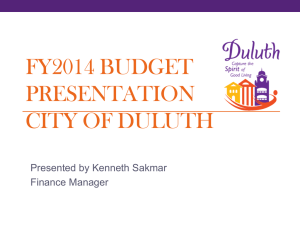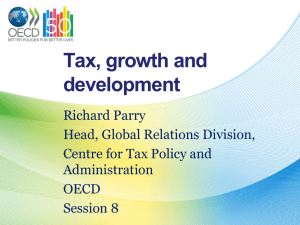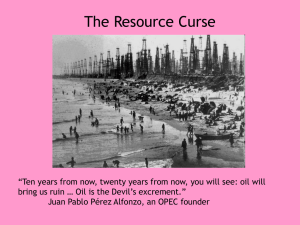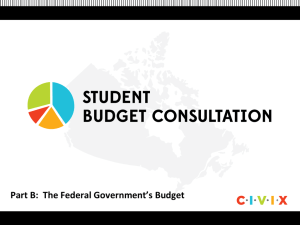view documents
advertisement
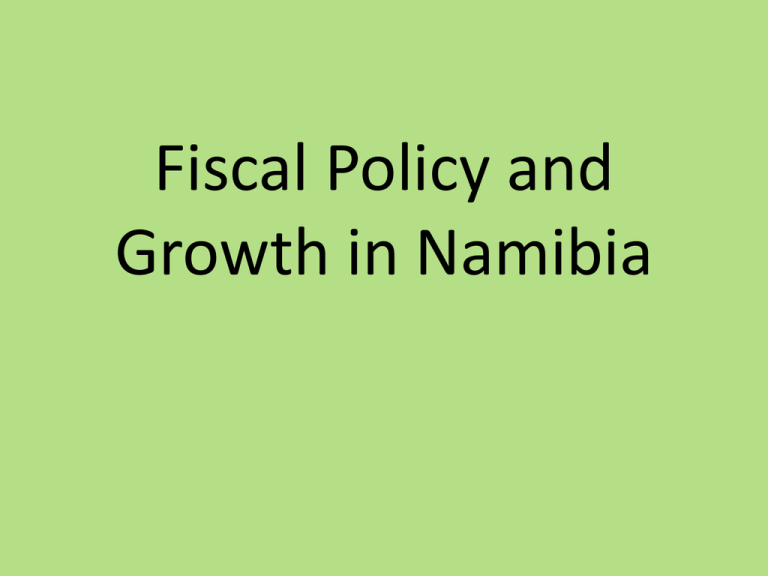
Fiscal Policy and Growth in Namibia Organisation of the Presentation 1. Theories on Fiscal Policy and Growth - Define growth and competitiveness - Fiscal policy and neoclassical theory - Keynesian and endogenous growth theory 2. Namibian Fiscal Policy - Consolidation of the budget, expenditures, revenues 3. Conclusion 1. Theories on Fiscal Policy and Growth • Neoclassical Theory: Supply Side Theory Support production by non-intervention market always finds its equilibrium again • Keynesian Theory: Demand Side Theory Support consumption when the economy in longterm disequilibrium • Endogenous Growth Theory: Synthesis Intervention, but as support for production only Define Growth and Competitiveness • Growth: Technical know how, progress in technical facilities (Innovations delivered by FDI) and accumulation of productive resources such as human capital • Competitiveness: Ability of domestic industries to produce at lower costs and deliver goods and services on higher quality than other industries in the global market Fiscal Policy and Neoclassical Theory • Growth can be raised by consolidation of the budget (reduction of expenditure), because this raises financial market confidence and lowers interest rates = Investments increase • Revenue collection should be neglected • Tax concessions are important to attract investments, taxes should be abolished Fiscal Policy and Keynesian Theory • Growth can be increased by countercyclical demand policy (increased expenditures) • Revenue collection is key for demand policy • A reduction of the deficit can lead to recessions • Direct taxes (progressive) are superior to indirect taxes (regressive) in triggering domestic demand Fiscal Policy and Endogenous Growth Theory • Certain expenditures lead to growth • Revenues can also be increased by tax increases • The indirect Value Added Tax (VAT) is superior to direct taxes because it is non-distortionary 2. Namibian Fiscal Policy and Growth The Consolidation of the Budget • Namibian Fiscal Policy is conservative= The balancing of the budget is a priority • 2001: MTEF introduced with fiscal target (budget deficit of 3% of GDP, public debt 25% of GDP, now extended to 30%) • 2005-2008 Saara Kuugongelwa-Amadhila managed to obtain a surplus by increasing revenues and decreasing expenditures Budget balance as percentage GDP 2003/2004 – 2006/2007 40 35 30 25 balance budget 20 Expenditure 15 10 Revenues 5 0 2003/2004 -5 -10 2004/2005 2005/2006 2006/2007 6 Foreign direct investment in- and outflows Namibia 1990-2009 5 Foreign direct investment, net inflows (% of GDP) 4 3 Foreign direct investment, net outflows (% of GDP) 2 1 0 1990 1991 1992 1993 1994 1995 1996 1997 1998 1999 2000 2001 2002 2003 2004 2005 2006 2007 2008 2009 -1 GDP growth at domestic prices at constant local currency GDP growth (annual %) 14 12 10 8 GDP growth (annual %) 6 4 2 0 1990 1991 1992 1993 1994 1995 1996 1997 1998 1999 2000 2001 2002 2003 2004 2005 2006 2007 2008 2009 -2 -4 Suggestions for Namibian Budget Policy • Saara Kuugongelwa-Amadhila followed an endogenous growth theory approach = lowered expenditures and increased revenues to balance budget • However, FDI and growth were not triggered • Suggestion: Investments can be obtained by infrastructure, education, internal market. = More expenditures in these areas increase competitiveness • In the 2011/12-2013/14 MTEF more expenditures to lower unemployment in Namibia Expenditures in Namibia • Even though the Minister of Finance reduced the expenditures before the financial crises, she increased them during and after the crises • With the 2011/2014 MTEF 104,000 jobs should be created by higher expenditures • However, the composition of the vote funds could be enhanced: Defence is the second highest receiver after education, more funds could go to the social expenditure and industry sector Expenditures by vote 2008/2009-2011/2012 in N$ billions 7 6 2008/2009 5 2009/2010 4 2010/2011 3 2011/2012 2 1 0 Police Defence Defence Education Gender equality and child welfare Health and Social Services Social Sector Labour and social services trade and industry agriculture Economic Sector Revenues in Namibia • SACU: collects customs for Namibia, Botswana, Swaziland, Lesotho and South Africa and channels the funds on basis of a formula to the countries again • 2008/2009 40% of Namibian tax revenues by SACU as customs, in 2011/2012 27.3%. • Need new revenues sources= increased the share of VAT and personal income taxes over the years, only low increase in corporate taxes and no increase in property taxes SACU revenues 2008-2014 taxes on international trade/ SACU 45.00 40.00 35.00 30.00 taxes on international trade/ SACU 25.00 20.00 15.00 10.00 5.00 0.00 2008-2009 2009-2010 2010-2011 2011-2012 2012-2013 2013-2014 The Composition of the Tax System • In Namibia 22% of the tax revenues are collected by VAT, 24% by personal income tax and 15% by corporate taxes, property tax is minimal • Supply side economics would suggest, that the VAT rate (15%) could be increased even further, but all other taxes should be lower • From a Keynesian point of view having indirect taxes collect half of the revenues is too high • Direct taxes (personal income, corporate, property) are progressive and indirect (VAT) are regressive= Higher demand and growth if VAT lower and other higher • Zero VAT for staple foods is a good step, luxury would also help Direct and indirect tax revenues 8.00 7.00 6.00 5.00 4.00 3.00 2.00 1.00 0.00 SACU goods and services indirect Company Taxes Individual income Other Taxes on Income and Profits direct Withholding tax on interests taxes on property indirect tax revenues direct tax revenues 47.38% 51.82% Company Taxes under Tax Competition • Corporate income tax is 35% • Their share on revenues increased only little over the years • The biggest share has the non-mining sector, mining and diamondmining have least share • Tax concessions: Manufacturing get a deduction of 50% in first years, EPZ companies are exempt • Tax concessions are in line with supply side economic theory • Alternative is: Raising mining taxes, cause industry depends on Namibian resources, funds can be channelled to manufacturing industry = competitiveness Company tax composition 2011/12 3.50 3.00 2.50 2.00 1.50 1.00 0.50 0.00 Non-Mining Diamond Mining Companies Other Mining Companies 3. Conclusion • Namibian supply side fiscal policy neither let to growth nor investments • Recommendations for the future are: • Increase expenditures for education, infrastructure, social spending and industry • Decrease spending on defence • Increase the share of direct taxes, such as property taxes and corporate taxes for the mining industry • Decrease indirect taxes (VAT)


